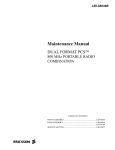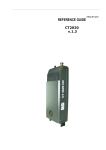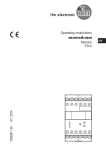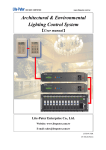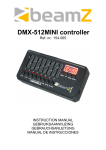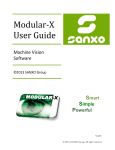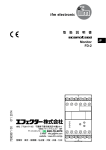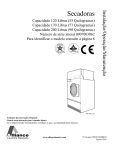Download BMS-Europe GmbH CT2020 Operating instructions
Transcript
Preliminary pages REFERENCE GUIDE HITACHI 2GHz Wireless HD System Fibre Package (HITACHI OEM Version) V 1.0 PRELIMINARY / DRAFT Reference Guide: HITACHI Wireless Camera (HITACHI OEM Version) March 2010 Page i Preliminary pages This document and the information contained in it is the property of Broadcast Microwave Services Inc. and may be the subject of patents pending and granted. It must not be used for commercial purposes nor copied, disclosed, reproduced, stored in a retrieval system or transmitted in any form or by any means (electronic, mechanical, photocopying, recording or otherwise), whether in whole or in part, without BMS’s prior written agreement. © 2009 Broadcast Microwave Services. All rights reserved. Issue 1 first published in 2010 by: Broadcast Microwave Services Europe GmbH & Co. KG Registered Address: Schwalbacher Straße 12 65321 Heidenrod – Kemel Germany Registered Company Number HRA 6230 Reference Guide: HITACHI Wireless Camera (HITACHI OEM Version) March 2010 Page ii Preliminary pages Contents 1 INTRODUCTION 1.1 Preliminary remarks ......................................................................... 1 1.2 Designation .................................................................................... 1 1.3 Delivered items ............................................................................... 1 1 1.4 Application of the HITACHI wireless transmitter .................................. 2 1.4.1 Typical application of the HITACHI fibre system ........................... 2 2 GETTING STARTED 2.1 Safety instructions ........................................................................... 3 2.2 Installing the HITACHI wireless camera components ............................ 3 3 2.3 Connectors ..................................................................................... 3 2.3.1 Antennas................................................................................. 4 2.3.1.1 2.3.1.2 2.3.2 2.3.3 2.3.4 2.3.5 3 UHF Antenna RF antenna 4 4 Power supply ........................................................................... 4 Intercom headset ..................................................................... 5 Microphones ............................................................................ 5 RS 232 ................................................................................... 5 CONFIGURING THE HITACHI WIRELESS CAMERA DIGITAL TRANSMITTER 5 3.1 Control panel .................................................................................. 5 3.1.1 The LC display ......................................................................... 6 3.1.2 The control buttons................................................................... 6 3.2 Menu structure ................................................................................ 6 3.2.1 Frequency ............................................................................... 8 3.2.2 Software version ...................................................................... 8 3.2.3 Display off ............................................................................... 9 3.2.4 Display brightness ...................................................................10 3.2.5 Data frequency .......................................................................11 3.2.6 Transmission power .................................................................12 3.2.7 Mic Phantom Power..................................................................12 3.2.8 Audio Rear Gain ......................................................................13 3.2.9 Audio Rear Input .....................................................................13 3.2.10 Audio Front Input ....................................................................14 3.2.11 Modulator Setup......................................................................14 3.2.12 Video Setup ............................................................................15 4 CONFIGURING THE HITACHI RECEIVE UNITS 4.1 Connection of the indoor units ..........................................................15 4.2 Installing the DR2500HD Receiver.....................................................16 Reference Guide: HITACHI Wireless Camera (HITACHI OEM Version) March 2010 15 Page iii Preliminary pages 4.3 Control buttons and Alarm status at the front of the device.................16 4.3.1 The Display ............................................................................16 4.3.2 The control buttons..................................................................16 4.3.3 Alarm and Status.....................................................................16 4.4 Connectors and indicators at the rear of the device..............................17 5 OPERATING THE DR2500ASI DECODER 5.1 Menu structure ................................................................................ D 5.2 PRESETS ........................................................................................ E 5.3 Frequency assignment...................................................................... F 5.4 Bandwidth selection ......................................................................... G 5.5 Save Preset ..................................................................................... I 5.6 Genlock...........................................................................................J 5.7 Main Sreen ..................................................................................... L 5.8 Contrast .........................................................................................M 5.9 Display OFF ....................................................................................M 5.10 A Software....................................................................................... N 6 OPERATING THE MODULARX IDU FIBRE 6.1 ModulaRX IDU Fibre Unit................................................................... N 6.2 Menu structure ................................................................................ O N UHF transmitter ..................................................................................... P 6.3 Intermodulation distortion................................................................. Q 6.4 Frequency table for data transmission................................................. Q 7 OPERATING THE FIBRE ODU 7.1 Menu structure of Fibre IDU .............................................................. T 7.2 Unlock Keyboard.............................................................................. U 7.3 Frequency RX.................................................................................. U 7.4 Frequency TX .................................................................................. U 7.5 Contrast ......................................................................................... U 7.6 Display OFF .................................................................................... V Reference Guide: HITACHI Wireless Camera (HITACHI OEM Version) March 2010 T Page iv Preliminary pages About this Reference Guide This Reference Guide provides instructions and information for the installation and operation of the HITACHI wireless transmitter. It is not a comprehensive manual for all camera functions. This Reference Guide should be kept in a safe place for reference for the life of the equipment. It is not intended that this Reference Guide will be amended by the issue of individual pages. Any revision will be by a complete reissue. If passing the equipment to a third party, please also pass on the relevant documentation. Issues of this Reference Guide are listed below: Issue 1 Date Build Version Comments March 2010 1.0 Draft Reference Guide: HITACHI Wireless Camera (HITACHI OEM Version) March 2010 Page v Preliminary pages Warnings, Cautions and Notes Heed Warnings All warnings on the product and in the operating instructions should be adhered to. The manufacturer can not be held responsible for injuries or damage where warnings and cautions have been ignored or taken lightly. Read Instructions All the safety and operating instructions should be read before this product is operated. Follow Instructions All operating and use instructions should be followed. Retain Instructions The safety and operating instructions should be retained for future reference. Warning Warnings give information which, if strictly observed, will prevent personal injury or death, OR DAMAGE TO PERSONAL PROPERTY OR THE ENVIRONMENT. They are boxed and shaded for emphasis, as in this example, and are placed immediately preceding the point at which the reader requires them. Cautions Cautions give information which, if strictly followed, will prevent damage to equipment or other goods. They are boxed for emphasis, as in this example, and are placed immediately preceding the point at which the reader requires them. Notes Notes provide supplementary information. They are highlighted for emphasis, as in this example, and are placed immediately after the relevant text. Reference Guide: HITACHI Wireless Camera (HITACHI OEM Version) March 2010 Page vi Chapter 1: Introduction Contact Information BMS Customer Services Support Services Our primary objective is to provide first class customer care that is tailored to your specific business and operational requirements. All levels are supported by one or more service performance reviews to ensure the perfect partnership between Broadcast Microwave Services and your business. Warranty All BMS Products and Systems are designed and built to the highest standards and are covered under a comprehensive 12 month warranty. Levels of Continuing BMS Service Support For stand-alone equipment, then Broadcast Microwave Services BASIC Advantage is the value for money choice for you. BASIC provides you with year-by-year Service long after the warranty has expired. For systems support you can choose either GOLD or SILVER Advantage. These packages are designed to save you costs and protect your income through enlisting the help of BMS support specialists. VOYAGER Advantage is the truly mobile service solution. This provides a package specifically designed to keep you mobile and operational. Call BMS Sales for more details. Where to Find Us Europe: Tel: + 49-6124-7239-0 Fax: + 49-6124-7239-29 [email protected] Americas: Tel: +1-858-391-3050 Fax: +1-858-391-3049 [email protected] Internet Address: http://www.bms-inc.com Reference Guide: HITACHI Wireless Camera (HITACHI OEM Version) March 2010 Page 1 Chapter 1: Introduction Technical Training Training Courses BMS provides a wide range of training courses on the operation and maintenance of our products and on their supporting technologies. BMS can provide both regularly scheduled courses and training tailored to individual needs. Courses can be run either at your premises or at one of our dedicated training facilities. Where to Find Us For further information on BMS training programme please contact us: International Telephone: + 49-6124-7239-0 (Europe) +1-858-391-3050 International Facsimile: + 49-6124-7239-29 (Europe) +1-858-391-3050 E-mail Address: (America) (America) [email protected] (Europe) [email protected] Internet Address: (America) http://www.bms-inc.com Customer Services and Technical Training Postal Address Broadcast Microwave Services Europe GmbH + Co. KG Schwalbacher Straße 12 65321 Heidenrod–Kemel Germany Return of Equipment If you need to return equipment for repair, please contact Tel: + 49 6124 7239-0 Fax: + 49 6124 7239-29 E-mail: [email protected] Address: see above. Technical Publications If you need to contact Broadcast Microwave Services Europe regarding this publication please e-mail to [email protected] Reference Guide: HITACHI Wireless Camera (HITACHI OEM Version) March 2010 Page 2 Chapter 1: Introduction 1 Introduction 1.1 Preliminary remarks The present document, "Reference Guide, HITACHI Wireless Camera (HITACHI OEM Version)”, is intended to be used for the proper set-up and operation of the wireless transmitter unit of the HITACHI camera system. 1.2 Designation Designation HITACHI 2GHz Wireless HD System Fibre Package (HITACHI OEM Version) Manufacturer: Broadcast Microwave Services Europe GmbH + Co. KG 1.3 Delivered items 1 x DR2420ODU-Fibre (P/N 12.1617.000) 1 x ModulaRX IDU Fibre (P/N 12.1620.000) 1 x OEM;CW-HD1000 (P/N 11.2501.000) Reference Guide: HITACHI Wireless Camera (HITACHI OEM Version) March 2010 Page 1 Chapter 1: Introduction 1.4 Application of the HITACHI wireless transmitter 2x Audio 230VAC HD-SDI Genlock Tally 2 .3 HD GH -S z DI/ Au dio /Da ta Data RX D at 45 a T X 50 5 M (U 0m H H W z) F 1.4.1 Typical application of the HITACHI fibre system Figure 1: Typical Application Reference Guide: HITACHI Wireless Camera (HITACHI OEM Version) March 2010 Page 2 Chapter 3: Operating the equipment 2 Getting started 2.1 Safety instructions Warning The regulations of VDE0100 must be observed for installation and operation of the unit. Caution • Before powering up the camera for the first time make sure all connections are completed. • Pay attention to all warnings in this document. • Make sure that the ventilation openings of the camera are not obstructed to ensure efficient heat dissipation. • The camera should be protected against moisture and humidity. 2.2 Installing the HITACHI wireless camera components The wireless transmitter of the HITACHI camera is integrated into the camera housing. 2.3 Connectors Please make sure you connect all antennas and cables to the below described connector jacks. Reference Guide: HITACHI Wireless Camera (HITACHI OEM Version) March 2010 Page 3 Chapter 3: Operating the equipment 2.3.1 Antennas Figure 2: Antenna Sockets 2.3.1.1 UHF Antenna Socket number 1 in Figure 2 is the UHF input for the intercom connection. To this socket a 50-Ohm UHF antenna must be mounted. 2.3.1.2 RF antenna Connect an active RF antenna to socket number 2 in Figure 2. You may need to apply an N-N adaptor. The impedance is 50 Ohm. Caution If you wish to connect other than the specified components (eg power amplifier or passive antennas) a DC blocker must be applied. Otherwise, your HITACHI Wireless Camera and/or other connected equipment may be damaged. Note The HF output supplies 5 VDC for an active antenna. 2.3.2 Power supply Most likely, your camera will be fed by a rechargeable battery. A V-mount bracket on the back side of the camera supports the battery housing. Reference Guide: HITACHI Wireless Camera (HITACHI OEM Version) March 2010 Page 4 Chapter 3: Operating the equipment If you desire to use an external power supply, you will find a 4-pole XLR 12 VDC input on the back side of the camera. As When connected to an external power supply the camera will switch from battery operation to the external power supply. 2.3.3 Intercom headset Connect the intercom headset to the 5-pole XLR socket on the back side of you camera. 2.3.4 Microphones The HITACHI Wireless Camera is equipped with two microphone input sockets on the back side. Connect your external microphones to these 3-pole XLR connectors. 2.3.5 RS 232 For servicing (eg software updates of the control panel) the wireless transmitter unit of the camera you may need to connect a PC to the RS 232 socket found below the control panel. 3 Configuring the HITACHI wireless camera digital transmitter 3.1 Control panel The digital transmitter unit of your HITACHI wireless camera is equipped with a control panel including control buttons and an LC display. Figure 3: Transmitter Unit Control Panel The control panel allows you to easily adjust the settings of the digital transmitter unit of your HITACHI Wireless Camera. Reference Guide: HITACHI Wireless Camera (HITACHI OEM Version) March 2010 Page 5 Chapter 3: Operating the equipment Note While configuring the digital transmitter you must not disconnect the power supply from the camera. This may cause loss of presets. 3.1.1 The LC display The HITACHI Wireless Camera digital transmitter unit is equipped with an LC display. This display simplifies the configuration. T. MHz Figure 4: LC Display Unless you are adjusting your transmitter parameters, the display shows the signal strength of the received camera control UHF signal in the upper left corner, an error code in the upper right corner and the adjusted transmitting frequency of the video and audio signal. 3.1.2 The control buttons The control buttons are located below the LC display on the control panel. These buttons are used for the navigation through the different menu items. Depending on the parameter to be changed the operator can use the control buttons “Up”/”Down” and/or “Left”/”Right”. Figure 5: Control Buttons 3.2 Menu structure After you switched on the HITACHI Wireless Camera the control panel of the digital transmitter unit shows an initialisation message. Once the initialisation phase has finished the main display (see Figure 4) is shown. Now you can access to the menu and adjust the different settings. Reference Guide: HITACHI Wireless Camera (HITACHI OEM Version) March 2010 Page 6 Chapter 3: Operating the equipment T. 6500 MHz 2328.000 MHz Figure 6: Menu Structure Reference Guide: HITACHI Wireless Camera (HITACHI OEM Version) March 2010 Page 7 Chapter 3: Operating the equipment 3.2.1 Frequency On the main display, press the button “OK” for approximately 3 seconds. The current frequency is shown. FREQUENCY MHz Figure 7: Frequency Menu After pressing “OK” another time for approximately 3 seconds the first digit of the frequency is highlighted and the display looks like shown in Figure 8. Press the “UP” control button to increase the value or the “DOWN” control button to decrease. To move to the next digit press the “RIGHT” control button or press the “LEFT” control button to jump back to the previous digit. Now adjust the frequency you wish to use. FREQUENCY Figure 8: Adjusting the Frequency To confirm the selected frequency press the “OK” button and the main menu will be shown. 3.2.2 Software version The control panel gives you the opportunity to show the recently installed software version. On the main display, press again the button “OK” for approximately 3 seconds. The current frequency is shown. Now use the “UP”/”DOWN” buttons to go to the “SOFTWARE” menu. No further adjustments can be made. The LC display shows the software version. Reference Guide: HITACHI Wireless Camera (HITACHI OEM Version) March 2010 Page 8 Chapter 3: Operating the equipment SOFTWARE Figure 9: Software Version Display 3.2.3 Display off In certain production environments you may want to switch the LC display off. On the main display, press the button “OK” for approximately 3 seconds. The current frequency is shown. Now use the “UP”/”DOWN” buttons to go to the “DISPLAY OFF” menu. DISPLAY OFF Figure 10: Display Off Menu Press the “OK” button again for approximately 3 seconds and the current display-off time level is highlighted. Use the “UP”/”DOWN” buttons in order to increase or decrease the display brightness in a range from 0 to 240 seconds in steps of 15 seconds. This is the time your display switches off after no button was pressed on the control panel. If you adjust the value to 0 seconds the display remains switched on. DISPLAY OFF Figure 11: Display-off Time Adjustment To confirm the selected display-off time press the “OK” button and the main menu will be shown. Note Once the display is switched off simply by pressing the “OK” button for Reference Guide: HITACHI Wireless Camera (HITACHI OEM Version) March 2010 Page 9 Chapter 3: Operating the equipment approximately 3 seconds it switches on again and you can use the menu. After the previously adjusted time without any action the display automatically switches off again. 3.2.4 Display brightness You may wish to adjust the brightness of the LC display to your production environment. On the main display, press the button “OK” for approximately 3 seconds. The current frequency is shown. Now use the “UP”/”DOWN” buttons to go to the “CONTRAST” menu. CONTRAST Figure 12: Contrast Menu Press the “OK” button again for approximately 3 seconds and the current contrast level is highlighted. Use the “UP”/”DOWN” buttons in order to increase or decrease the display brightness in a range from 0 to 15. 0 is the darkest adjustment, 15 the highest brightness. CONTRAST Figure 13: Display Brightness Adjustment Reference Guide: HITACHI Wireless Camera (HITACHI OEM Version) March 2010 Page 10 Chapter 3: Operating the equipment To confirm the selected brightness level press the “OK” button and the main menu will be shown. 3.2.5 Data frequency The camera may be connected to a CCU via an UHF wireless connection. In the “DATA FREQUENCY” menu you have the possibility to adjust the frequency of the channel. On the main display, press the button “OK” for approximately 3 seconds. The current frequency is shown. Now use the “UP”/”DOWN” buttons to go to the “DATA FREQUENCY” menu. DATA FREQUENCY Figure 14: Data Frequency Menu After pressing “OK” another time for approximately 3 seconds the data frequency is shown red. Use the control buttons to adjust the frequency in steps of 0.01 MHz. DATA FREQUENCY Figure 15: Adjusting the Data Frequency To confirm the selected frequency press the “OK” button and the main menu will be shown. Reference Guide: HITACHI Wireless Camera (HITACHI OEM Version) March 2010 Page 11 Chapter 3: Operating the equipment 3.2.6 Transmission power In order to trim the transmission power to your environment you can choose between three preset power levels in the “OUTPUT POWER” menu. On the main display, press the button “OK” for approximately 3 seconds. The current frequency is shown. Now use the “UP”/”DOWN” buttons to go to the “OUTPUT POWER” menu. OUTPUT POWER Figure 16: Output Power Menu Press the “OK” button again for approximately 3 seconds and the current output power level is highlighted. With the “UP”/”DOWN” control buttons you can choose between low, medium and high transmission power. OUTPUT POWER MEDIUM LOW Figure 17: Output Power Adjustment (Low=10mW; Medium=100mW; High=400mW).To confirm the selected power level press the “OK” button and the main menu will be shown. 3.2.7 Mic Phantom Power The control panel gives you the opportunity to enable the MIC phantom power if “MIC” is selected in the menu “AUDIO REAR INPUT”. MIC PHANTOM POWER Figure 13: Software Version Display Reference Guide: HITACHI Wireless Camera (HITACHI OEM Version) March 2010 Page 12 3.2.8 Audio Rear Gain If you connect an audio signal to the “Rear Audio” connector at the back of the camera, then you can adjust the gain of the signal. In order to adjust the audio gain you can choose between the values +30….-10dB in the “AUDIO REAR GAIN” menu. On the main display, press the button “OK” for approximately 3 seconds. The current frequency is shown. Now use the “UP”/”DOWN” buttons to go to the “AUDIO REAR GAIN” menu. AUDIO REAR GAIN Figure 14: Audio Rear Gain Press the “OK” button again for approximately 3 seconds and the current gain level is highlighted. With the “UP”/”DOWN” control buttons you can choose between the values +30….-10dB. 3.2.9 Audio Rear Input In order to select the audio input you can choose between “LINE” and “MIC” On the main display, press the button “OK” for approximately 3 seconds. The current frequency is shown. Now use the “UP”/”DOWN” buttons to go to the “AUDIO REAR INPUT”” menu. AUDIO REAR INPUT Figure 15: Audio Rear Input Press the “OK” button again for approximately 3 seconds and the current input is highlighted. With the “UP”/”DOWN” control buttons you can choose between “MIC” and “LINE”. Reference Guide: HITACHI Wireless Camera (HITACHI OEM Version) March 2010 Page 13 Note If you select “LINE” you will not see the “MIC PHANTOM POWER” sub menu 3.2.10 Audio Front Input Having VF SETUP selected in this sub menu you will be able to adjust the audio of the front microfone through the viewfinder menu. AUDIO FRONT INPUT Figure 16: Audio Front Input 3.2.11 Modulator Setup This setup shows you the current modulation of the transmitter. It is not possible to change something. MODULATOR SETUP FEC 2/3 GUARD 1/32 Figure 17: Modulator Setup Reference Guide: HITACHI Wireless Camera (HITACHI OEM Version) March 2010 Page 14 3.2.12 Video Setup This setup shows you the current video parameters. It is not possible to change something. VIDEO SETUP 29,97 fps Figure 17: Modulator Setup 4 Configuring the HITACHI Receive units 4.1 Connection of the indoor units In the figure 18 you can see how to connect the devices with the delivered cables. 5 9 4 8 3 7 2 6 1 17.1165.401 Figure 18: How to connect the cables to the devices Reference Guide: HITACHI Wireless Camera (HITACHI OEM Version) March 2010 Page 15 4.2 Installing the DR2500HD Receiver The DR2505-ASI decoder can be accommodated in a 19" rack with a height of 1 RU. 4.3 Control buttons and Alarm status at the front of the device 4.3.1 The Display A LC display is used to show the RF and COFDM parameters and the configuration parameters. DR2500-ASI MER/dB 1: 2: 00 00 Status: Unlocked Const: -- FEC: -- 01 2349.00MHz Guard: -- Figure 1 :19: LCD Figure LCDDisplay Display 4.3.2 The control buttons The control buttons are located on the right side of the front panel. They allow navigation of the different receiver DR2500HD menus. Depending on the parameter to be changed the operator can use the control buttons “UP”/”Down” and/or “Left”/”Right” OK Figure 2 Figure : Control 20:buttons Control buttons 4.3.3 Alarm and Status Lights up, when the tuned Frequency differs from the allowed Frequency range of the receiver (Fibre-ODU). The DR2500-ASI switches automatically to the next highest or lowest adjustable Frequency. Lights up, when the DR2500ASI doesn’t receive any signals (Unlocked). Once a signal is received, the light switches off. Reference Guide: HITACHI Wireless Camera (HITACHI OEM Version) March 2010 Page 16 Lights up, when the DR2500-ASI is powered by the power supply. 4.4 Connectors and indicators at the rear of the device ASI in Genlock HD-SDI L Audio R µPC/Data 12VDC AUX HD-SDI Figure 3 21::Rear of the Figure Rear ofDR2500ASI the DR2500HD Diversity Receiver At the rear of the DR2500HD Diversity Receiver: • 1 X “ASI in”, this is the ASI signal which comes from the Fibre-IDU • 1 X “Genlock in” for Synchronization [SD- or HD-SDI], BNC female • 2 X “SDI out” for video, BNC female • 1 X "12-18V-DC" 4-pol XLR connector for 12-18V DC power supply • “Ant.1” and “Ant.2”are 2 X SMA (f) sockets for RF input • 1 X “uPC/Data” is a Serial 9 pin Sub-D (f) socket for remote control RX and data output • “Audio L” and “Audio R” are 3-pol XLR connector for audio out Caution Be sure that the ventilation openings are not obstructed. Reference Guide: HITACHI Wireless Camera (HITACHI OEM Version) March 2010 Page 17 5 Operating the DR2500ASI decoder When the DR2500ASI is connected to a power supply, the display at the front of the unit will light up. During the initialisation phase, the company’s name, receiver’s name as well as the software version are displayed. The operation of the unit is controlled using the control elements located at the front panel. BMS inc DR2500-ASI v2.04 Figure 4 : Initialisation phase Figure 22: Initalisation phase After that the initialisation phase is done the receiver switches automatically to the “Main Display” see Figure 6. DR2524-HD MER/dB 1: 2: 22 24 Status: Locked Const: 64QAM FEC: 2/3 01 2349.00MHz GL (AUTO) Guard: 1/32 Figure 5 :23:Main Display Figure Main display In case that there is good transmission at the set frequency, you will get the overview displayed like in the Picture shown in “Figure 6” On top of the right side you can see the model name of the receiver and under the model name are displayed the selected preset and the frequency which is stored in that preset. On the left side the bar graph for the MER value is shown. In “Figure 6” the bar graph value would be 0 in case of bad reception, because no transmission is received at the moment by the receiver. Bar graph “1:” shows the MER from antenna 1 and “2:” shows the value from antenna 2. Reference Guide: HITACHI Wireless Camera (HITACHI OEM Version) March 2010 Page A Note The modulation error ratio (MER) is a measure of the SNR in a digitally modulated signal. Like SNR, MER can be expressed in dB. Signal-to-noise (SNR or S/N) is an electrical engineering measurement, defined as the ratio of a signal power to the noise power corrupting the signal. Signal-tonoise ratio compares the level of a desired signal to the level of background noise. The higher the ratio, the less obtrusive the background noise is. • Status: Unlocked : will be displayed when any signal is received Locked : will be displayed when a signal is received At the bottom of the display the Constellation, FEC and Guard Interval will be shown automatically, if a signal is received and decoded by the receiver. • Guard: 1/4, 1/8, 1/16, 1/32 can be displayed depending on the bandwidth of the transmitted signal In COFDM, the beginning of each symbol is preceded by a guard interval. As long as the echoes fall within this interval, they will not affect the receiver's ability to safely decode the actual data, as data is only interpreted outside the guard interval. Longer guard periods allow more distant echoes to be tolerated. However, longer guard intervals reduce the channel efficiency. In DVB-T, four guard intervals are available (given as fractions of a symbol period): 1/32 ; 1/16 ; 1/8 ; 1/4 Hence, 1/32 gives lowest protection and the highest data rate. 1/4 results in the best protection but the lowest data rate • FEC: 1/2, 2/3, 3/4, 5/6 can be displayed depending on the FEC of the transmitted signal Forward Error Correction (FEC) is a system of error control for data transmission, whereby the sender adds redundant data to its messages, also known as an error-correction code. This allows the receiver to detect and correct errors (within some bound) The advantage of forward error correction is that a back-channel is not required, at the cost of higher bandwidth requirements on average. Reference Guide: HITACHI Wireless Camera (HITACHI OEM Version) March 2010 Page B • Const: QPSK, 16 QAM, 64 QAM can be displayed depending on the modulation mode of the transmitted signal Constellation (DVB-T Modulation) mode can be between QPSK, 16QAM and 64QAM. QPSK is the default mode (in SD transmission) and will give the strongest most rugged RF link performance. Selecting 16QAM reduces the link performance by 5dB but improves the link data throughput, giving significantly better video quality. 64QAM is the constellation mode for HD transmission due to the high data rate. Reference Guide: HITACHI Wireless Camera (HITACHI OEM Version) March 2010 Page C 5.1 Menu structure D R 2 5 2 4-H D M E R /d B 1: 2: S tatu s: L o cked C o nst: 64Q A M 22 24 F E C : 2/3 01 2 3 4 9.0 0M H z G L (A U T O ) G u ard : 1/32 M a in S cre e n PRESET P R E S E T 1 … ...P R E S E T 2 6 FREQ UENCY T ra n sm issio n fre q u e n cy se t B A N D W ID T H 6M Hz / 7M H z / 8M Hz SAVE PRESET YES / NO G ENLO CK O FF / AUTO / O N M a in S c re e n F R E Q U E N C Y / M E R in d B CO NTRAST 0 0 0 ...1 2 7 D IS P L A Y O F F 0 0 0 ...2 4 0 se co n d s SO FTW ARE S o ftw a re V e rsio n Reference Guide: HITACHI Wireless Camera (HITACHI OEM Version) March 2010 Page D 5.2 PRESETS Press the button “OK” for 2-3 seconds to enter the main menu. The first submenu is the “PRESET”-menu, where it is possible to select 26 different presets. Each preset can contain a different frequency which the customer can assign due to his needs. DR2500-ASI PRESET 01 2349.00MHz To change the preset number press again the button “OK” for 2-3 seconds to be able to change the preset. Two small triangle will show that the change mode is activated. DR2500-ASI PRESET 01 2349.00MHz Now it is possible to select with the UP/DOWN button 1 of 26 presets. To confirm the selected preset press the “OK” button and after that it will appear “UPDATING DEVICE”. DR2500-ASI PRESET 26 UPDATING DEVICE Note A quick button press will return you to the previous menu to effect and save the changes and another quick press takes you away from the main menu Reference Guide: HITACHI Wireless Camera (HITACHI OEM Version) March 2010 Page E 5.3 Frequency assignment Press the button “OK” for 2-3 seconds to enter in the main menu and one time the right button for the frequency option. This menu gives the user the possibility to set the frequency manually without using the preset option. DR2500-ASI FREQUENCY 2385.00MHZ Press again the button “OK” for 2-3 seconds to be able to change the frequency range. After pressing “OK” for the second time the first digit is highlighted and the display looks like in figure 7. Press the “UP” control button to increase the digit and the “DOWN” to decrease, to move to the second digit press the “RIGHT” control button or Press the “LEFT” to come back to the previous digit. DR2500-ASI FREQUENCY 22385.00MHZ To confirm the frequency press the “OK” button and after that it will appear “UPDATING DEVICE”. DR2500-ASI FREQUENCY 2385.00 MHZ UPDATING DEVICE Reference Guide: HITACHI Wireless Camera (HITACHI OEM Version) March 2010 Page F Note A quick button press will return you to the previous menu to effect and save the changes and another quick press takes you away from the main menu DR2500-ASI MER/dB 1: 2: Status: Locked Const: 64QAM ** 22 24 FEC: 2/3 2388.00MHz GL (AUTO) Guard: 1/32 At the position where normally the preset number is shown, there are displayed two stars “**”, which is an indication for the user, that no preset is set, but a manually frequency. 5.4 Bandwidth selection Press the button “OK” for 2-3 seconds to enter the main menu. The third submenu is the “BANDWIDTH”-menu, where it is possible to select 3 different bandwidth (6 / 7 / or 8 MHz). Before changing the bandwidth, please check the bandwidth setting of your transmitter. DR2500-ASI BANDWIDTH 8 MHz Note For HD transmission you have to set the bandwidth to 8 MHz. Reference Guide: HITACHI Wireless Camera (HITACHI OEM Version) March 2010 Page G To change the bandwidth press again the button “OK” for 2-3 seconds to be able to change the setting. Two small triangle will show that the change mode is activated. DR2500-ASI BANDWIDTH 8 MHz Now it is possible to select with the UP/DOWN button the bandwidth of the transmitted signal you want to receive. To confirm the selected preset press the “OK” button and after that it will appear “UPDATING DEVICE”. DR2524-HD BANDWIDTH 8 MHz UPDATING DEVICE Note A quick button press will return you to the previous menu to effect and save the changes and another quick press takes you away from the main menu Reference Guide: HITACHI Wireless Camera (HITACHI OEM Version) March 2010 Page H 5.5 Save Preset If a frequency has been set in the “Frequency” option, described in Chapter 3.3, it is possible to save this frequency in one of the 26 Preset options. To save a frequency in a Preset, follow the steps: 1. Select the Preset you want to store the new frequency (Chapter 3.2) 2. Set the new frequency (Chapter 3.3) 3. Save preset: Press the button “OK” for 2-3 seconds to enter in the main menu and two times the right button for the “SAVE PRESET” option. DR2524-HD SAVE PRESET ? Reference Guide: HITACHI Wireless Camera (HITACHI OEM Version) March 2010 Page I This menu gives the user the possibility to save a frequency under the current preset. Now press again the button “OK” for 2-3 seconds and you will have the choice between “YES” (to save frequency to current preset) and press the OK button. DR2524-HD SAVE PRESET YES Now the frequency is stored to the preset. 5.6 Genlock If a genlock is used with the DR2500HD receiver, the user will have some options to set the genlock function. Press the button “OK” for 2-3 seconds to enter in the main menu and three times the right button for the “GENLOCK” option and press again the “OK” button for 2-3 seconds. Press the “UP” or “DOWN” control button to select one of the three options which are given to the user in this menu: OFF / AUTO / ON 1) OFF – the receiver will not use any external genlock DR2524-HD MER/dB 1: 2: Status: Locked Const: 64QAM ** 22 24 FEC: 2/3 2388.00MHz Guard: 1/32 Reference Guide: HITACHI Wireless Camera (HITACHI OEM Version) March 2010 Page J 2) ON - the receiver will use the external genlock DR2524-HD MER/dB 1: 2: ** 22 24 Status: Locked Const: 64QAM FEC: 2/3 2388.00MHz GL=Genlock „ON“ GL Guard: 1/32 Note If Genlock “ON” is selected but no Genlock signal is present, the decoder will not be able to decode any signal 3) AUTO – the receiver will detect automatically if an external genlock is connected DR2524-HD MER/dB 1: 2: Status: Locked Const: 64QAM ** 22 24 FEC: 2/3 2388.00MHz GL=Genlock „AUTO“ GL (AUTO) Guard: 1/32 Now press again the button “OK” for 2-3 seconds to confirm your choice. Reference Guide: HITACHI Wireless Camera (HITACHI OEM Version) March 2010 Page K 5.7 Main Sreen It is possible to choose between two Main Screens. Press the button “OK” for 2-3 seconds to enter in the main menu and four times the right button for the “Main Screen” option and press again the “OK” button for 2-3 seconds. Press the “UP” or “DOWN” control button to select one of the two options: Frequency or MER in dB. 1) Main Screen (FREQUENCY) DR2524-HD FREQUENCY 2385.00MHZ In this display you will get only the frequency displayed and the device model. 2) Main Screen (MER in dB) DR2524-HD MER/dB 1: 2: 22 24 Status: Locked Const: 64QAM FEC: 2/3 01 2349.00MHz GL (AUTO) Guard: 1/32 The display shows you different information at the same time: - MER/dB for antenna1 and antenna 2 - Status of incoming signal (locked or unlocked) - Modulation of received and decoded Signal (QPSK/16QAM/64QAM) - FEC (1/2;2/3;4/4;5/6;7/8) - Guard interval (1/4;1/8;1/16;1/32) - Genlock setting ( AUTO]) - Preset number and frequency (if preset is selected) or only frequency if no preset is selected [Genlock OFF]; GL [Genlock ON]; GL (AUTO); [Genlock Reference Guide: HITACHI Wireless Camera (HITACHI OEM Version) March 2010 Page L 5.8 Contrast Press the button “OK” for 2-3 seconds to enter in the main menu, and then press twice the control button “RIGHT” to select the sub menu “CONTRAST”. Press again the button “OK” for 2-3 seconds and then press the control button “UP” or “DOWN” to choose between a range from 000 to 127. The higher the digit the brighter the display. DR2524-HD CONTRAST 010 Note A quick button press short will return you to the previous menu and save the changes. A quick button press exits the main menu 5.9 Display OFF Press the button “OK” for 2-3 seconds to enter in the main menu, then press three times the control button “RIGHT” to select the sub menu “DISPLAY OFF”. Press again the button “OK” for 2-3 seconds and then press the control button “UP” or “DOWN” to choose between 000s to 240s. The user can choose the time after which the unit would automatically switch off the display. DR2524-HD Display OFF 000 Reference Guide: HITACHI Wireless Camera (HITACHI OEM Version) March 2010 Page M Note A quick button press will return you to the previous menu and save the changes Another quick press exits the main menu. 5.10 Software Press the button “OK” for 2-3 seconds to enter in the main menu, then press four times control button “RIGHT” control button to navigate in the main menu and select the “SOFTWARE”. The software version will be displayed. DR2524-HD SOFTWARE V2.04 Note A quick press returns you to the main menu 6 Operating the ModulaRX IDU Fibre 6.1 ModulaRX IDU Fibre Unit IDU RX RCP: OK CAM: OK DATA-TX: DATA-RX: Reference Guide: HITACHI Wireless Camera (HITACHI OEM Version) March 2010 DataTX 465.53MHz/CH129 UHF-DATA: OK COFDM-DATA:OK Page N 6.2 Menu structure ID U R X RCP: OK CAM: OK D A T A -T X : D A T A -R X : D a ta T X 4 6 5 .5 3 M H z/C H 1 2 9 U H F -D A T A : O K C O F D M -D A T A :O K M a in S cre e n D A T A -F R E Q U E N C Y M A IN S C R E E N CO NTRAST D IS P L A Y O F F SO FTW ARE Alarm and Status The following chapter describes the meaning of the different status of the unit. DataTX Shows the current frequency from the data transmitter which is inbuilt into the outdoor unit. COFDM o.k. “OK” lights up, when the transmission between the camera transmitter and the Fibre ODU Diversity receiver is properly. When “fail” appears, please check the transmission between the CT2020 transmitter and the diversity receiver. UHF o.k. “OK” lights up, when the transmission between UHF transmitter and the camera transmitter is properly. When “fail” appears, please check if all cables are properly connected at the UHF transmitter site. Data-TX Lights up, when data is transmitted to the camera Light up permanently only when data are transmitted. Reference Guide: HITACHI Wireless Camera (HITACHI OEM Version) March 2010 Page O RCP Lights up, when the RCP is not connected or configured wrong In normal mode the light should be switched off Camera “OK” lights up, when the Camera is transmitting “FAIL” will show a problem with the transmitter. UHF transmitter To power supply the UHF transmitter, connect the 12VDC power supply to the 4-XLR (m) connector of the UHF transmitter. Connect the “DATA IN” by using the BNC cable from the OCP Interface “DATA out”. UHF frequency set up Press the button (o) for to enter in the main menu and a second time to change the frequency. Then set up the frequency using the “up” and “down” control buttons. Reference Guide: HITACHI Wireless Camera (HITACHI OEM Version) March 2010 Page P 6.3 Intermodulation distortion Intermodulation distortion, commonly known as Intermods, is a type of interference that can occur in any non-linear junction. It exists when more than one signal is present at the same time. These fundamentals signals, known as carrier signals, can combine to create new, unwanted frequencies resulting in interference. E.g. using many UHF transmitters at the same time can produce intermodulation interference. To avoid the third order intermodualtion interference and/or near far problem, which can be an issue when many channels are being used in the same area. We recommend to create a channel plan by using software packages which can assist in calculating intermodulation products. 6.4 Frequency table for data transmission Kanal 1 2 3 4 5 6 7 8 9 10 11 12 13 14 15 16 17 18 19 20 21 22 23 24 25 26 27 28 29 30 31 32 33 Frequenz [MHz] 455,8500 455,8600 455,8700 455,8800 455,8900 455,9000 455,9100 455,9200 455,9300 455,9400 455,9500 455,9600 455,9700 455,9800 455,9900 456,0000 456,0100 456,0200 456,0300 456,0400 456,0500 456,0600 456,0700 456,0800 456,0900 456,1000 456,1100 456,1200 456,1300 456,1400 456,1500 456,1600 456,1700 Kanal 129 130 131 132 133 134 135 136 137 138 139 140 141 142 143 144 145 146 147 148 149 150 151 152 153 154 155 156 157 158 159 160 161 Reference Guide: HITACHI Wireless Camera (HITACHI OEM Version) March 2010 Frequenz [MHz] 465,5300 465,5400 465,5500 465,5600 465,5700 465,5800 465,5900 465,6000 465,6100 465,6200 465,6300 465,6400 465,6500 465,6600 465,6700 465,6800 465,6900 465,7000 465,7100 465,7200 465,7300 465,7400 465,7500 465,7600 465,7700 465,7800 465,7900 465,8000 465,8100 465,8200 465,8300 465,8400 465,8500 Page Q 34 35 36 37 38 39 40 41 42 43 44 45 46 47 48 49 50 51 52 53 54 55 56 57 58 59 60 61 62 63 64 65 66 67 68 69 70 71 72 73 74 75 76 77 78 79 80 81 82 83 84 85 86 87 88 456,1800 456,1900 456,2000 456,2100 456,2200 456,2300 456,2400 456,2500 456,2600 456,2700 456,2800 456,2900 456,3000 456,3100 456,3200 456,3300 456,3400 456,3500 456,3600 456,3700 456,3800 456,3900 456,4000 456,4100 456,4200 456,4300 456,4400 456,4500 456,4600 456,4700 456,4800 456,4900 456,5000 456,5100 456,5200 456,5300 456,5400 456,5500 456,5600 456,5700 456,5800 456,5900 456,6000 456,6100 456,6200 456,6300 456,6400 456,6500 456,6600 456,6700 456,6800 456,6900 456,7000 456,7100 456,7200 162 163 164 165 166 167 168 169 170 171 172 173 174 175 176 177 178 179 180 181 182 183 184 185 186 187 188 189 190 191 192 193 194 195 196 197 198 199 200 201 202 203 204 205 206 207 208 209 210 211 212 213 214 215 216 Reference Guide: HITACHI Wireless Camera (HITACHI OEM Version) March 2010 465,8600 465,8700 465,8800 465,8900 465,9000 465,9100 465,9200 465,9300 465,9400 465,9500 465,9600 465,9700 465,9800 465,9900 466,0000 466,0100 466,0200 466,0300 466,0400 466,0500 466,0600 466,0700 466,0800 466,0900 466,1000 466,1100 466,1200 466,1300 466,1400 466,1500 466,1600 466,1700 466,1800 466,1900 466,2000 466,2100 466,2200 466,2300 466,2400 466,2500 466,2600 466,2700 466,2800 466,2900 466,3000 466,3100 466,3200 466,3300 466,3400 466,3500 466,3600 466,3700 466,3800 466,3900 466,4000 Page R 89 90 91 92 93 94 95 96 97 98 99 100 101 102 103 104 105 106 107 108 109 110 111 112 113 114 115 116 117 118 119 120 121 122 123 124 125 126 127 128 456,7300 456,7400 456,7500 456,7600 456,7700 456,7800 456,7900 456,8000 456,8100 456,8200 456,8300 456,8400 456,8500 456,8600 456,8700 456,8800 456,8900 456,9000 456,9100 456,9200 456,9300 456,9400 456,9500 456,9600 456,9700 456,9800 456,9900 457,0000 457,0100 457,0200 457,0300 457,0400 457,0500 457,0600 457,0700 457,0800 457,0900 457,1000 457,1100 457,1200 217 218 219 220 221 222 223 224 225 226 227 228 229 230 231 232 233 234 235 236 237 238 239 240 241 242 243 244 245 246 247 248 249 250 251 252 253 254 255 256 Reference Guide: HITACHI Wireless Camera (HITACHI OEM Version) March 2010 466,4100 466,4200 466,4300 466,4400 466,4500 466,4600 466,4700 466,4800 466,4900 466,5000 466,5100 466,5200 466,5300 466,5400 466,5500 466,5600 466,5700 466,5800 466,5900 466,6000 466,6100 466,6200 466,6300 466,6400 466,6500 466,6600 466,6700 466,6800 466,6900 466,7000 466,7100 466,7200 466,7300 466,7400 466,7500 466,7600 466,7700 466,7800 466,7900 466,8000 Page S 7 Operating the Fibre ODU 7.1 Menu structure of Fibre IDU LOC KED 2 3 2 8 .0 0 0 MHZ M a in S cre e n FREQ UENCY RX FREQ UENCY TX CO NTRAST D IS P L A Y O F F SO FTW ARE Reference Guide: HITACHI Wireless Camera (HITACHI OEM Version) March 2010 Page T 7.2 Unlock Keyboard To be able to enter the submenu you must unlock the keyboard. Press the two arrow buttons at the same time to unlock the keyboard 7.3 Frequency RX In this menu you can set the frequency for the reception of the camera signal. Press the button (o) for 2-3 seconds to enter in the main menu and a second time to change the frequency. Then set up the RX frequency using the “up” and “down” control buttons. Please be sure that the frequency you set is the same frequency the camera is transmitting. 7.4 Frequency TX In this menu you can set the frequency for the data transmitter for the remote control of the camera. Press the button (o) for 2-3 seconds to enter in the main menu and a second time to change the frequency. Then set up the frequency using the “up” and “down” control buttons. 7.5 Contrast Press the button (o) for 2-3 seconds to enter in the main menu and a second time to change the contrast of the display. Press again the button (o) for 2-3 seconds and then press the control button “UP” or “DOWN” to choose between a range from 000 to 127. The higher the digit the brighter the display. Reference Guide: HITACHI Wireless Camera (HITACHI OEM Version) March 2010 Page U 7.6 Display OFF Press the button (o) for 2-3 seconds to enter in the main menu and a second time to change the display off value. Press again the button “OK” for 2-3 seconds and then press the control button “UP” or “DOWN” to choose between 000s to 240s. The user can choose the time after which the unit would automatically switch off the display. Reference Guide: HITACHI Wireless Camera (HITACHI OEM Version) March 2010 Page V















































